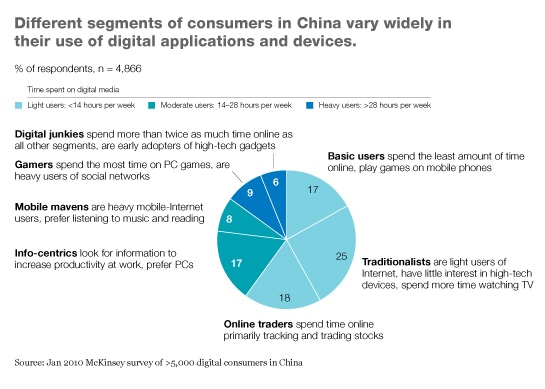China could have as many as 750 million people online by 2015, up from 420 million today, McKinsey research estimates. Who are these Internet users? Which applications drive them online, and what makes them stay there? Which devices are they using, and how will that change over time? Marketers seeking to reach China’s swelling population need these details to make informed business decisions.
In 2010, we surveyed more than 5,000 of these consumers in upward of 20 Chinese cities. In addition to collecting basic demographic data, we asked the respondents questions that helped us assess two critical dimensions of their digital personas. The first was how much time consumers spend on digital devices (such as mobile phones and smart phones, PCs, TVs, and game consoles) and how they allocate their time among various applications (e-mail, instant messaging, games). The second dimension was how much money consumers spend on digital devices and applications.
Our research revealed seven consumer segments, with widely varying usage patterns and preferences for digital applications and devices (exhibit). The largest segment, the “traditionalists,” comprises a whopping 125 million consumers, who still spend a large portion of their media time on traditional forms such as television and are less likely to own, or want to own, other digital devices. They are less educated than the rest of the Internet users, and many live in smaller cities.

Even the smallest segment, the “digital junkies,” has 25 million of the planet’s most intensive Internet users. They spend more than 34 hours a week with digital media, compared with an average of 15.8 hours for all users. People in this segment are young and always on the lookout for the latest gadget; more than 25 percent of them live in one of China’s four biggest cities.
Whether it’s applications, digital devices, or e-commerce business models, no one size fits all in China. The substantial differences among the country’s digital consumers show that marketers must develop tailored offerings for them.
